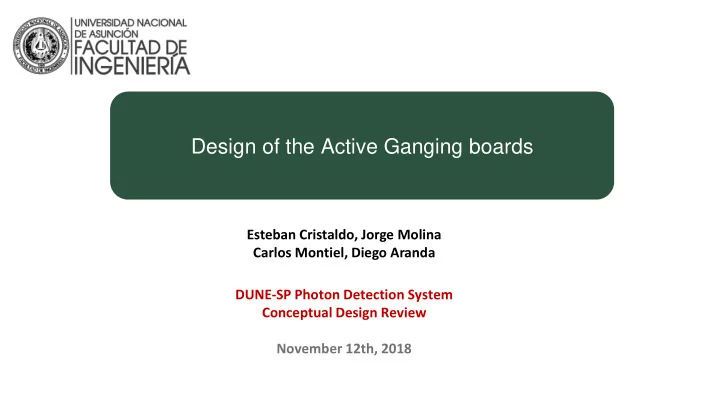

Design of the Active Ganging boards Esteban Cristaldo, Jorge Molina Carlos Montiel, Diego Aranda DUNE-SP Photon Detection System Conceptual Design Review November 12th, 2018
CASE OF STUDY We want to know if we can amplify 12 SiPM in paralell (active ganging ) with one output channel. We simulate a Charge amplifier transimpedance model and a Charge integrator model 2
Design scheme Three stages of the circuit for 48 SiPM: Addition LPF stage c harge integrators or transimpedance 3
Two preamps models studied Transimpedance model Charge integrator model • • This is a first order low pass filter This is a second order band pass filter • • Rf and Cf establish the bandwith Cf and Cs establish the bandwith and and frequency cut point frequency cut point • • Eliminates high frequency noise Eliminates low and high frequency noise 4
Comparison between Transimpedance and Charge Integrator Transimpedance model Charge integrator model • • Cut of 20 dB per decade. Cut of 40dB per decade • • Range of frecuency from the first to Range of frequency form zero to first pole second pole. (with low frequency noise) • • The SiPM is connected to the Direct coupling from the SiPM to the filter. decoupling capacitor. 5
Simulation outline Charge Output integrator or Signal SiPM transimped. Dark Noise Noise generator Noise Both models are running using Hamamatsu’s parameters for single photon analysis at LAr temperatures (thanks to Vishnu for sending the detector parameters!) 6
Results for the transimpedance 7
Results for charge integrator 8
We cannot see a big diference between them in the response. The best values of SNR the we obtained are about 8 dB and a 1 us of settling time in both topologies. 9
Dark noise for 48 SiPM We see that we should no worried about the dark noise 10
How many samples per second? We think that we can do well with a 20 MSPS 11
How many bits for dynamic range? 12 Results for transimpedance preamp
Random generation of 10 photons striking the detectors in one channel 13
COLD ELECTRONICS TESTS 4 boards with 12 actively ganged hammamatsu SiPM 14
15 For transimpedance R1, R2, R3 & R10left open; and C4, C5, C6 & C11 are shorted
16
Current scientific requierements 17
Conclusions 1. We presented a very powerful tool that can be used in the design of the electronics needed. 2. We showed that is possible to gang 48 SiPM and distinguish single photon signals with less than 1 µs width (recovery time included). 3. For single photons there is no significant difference between both models in duration of the pulse and S/N ratio. Preliminary simulations indicates that for 10 photons we don’t see any difference either. 4. The S/N ratio obtained is about 8 dB, with all noise effects included (thermal, DN). 5. The optimal sampling rate obtained is >≈ 20 MSPS. 6. The design of the board for the ICEBERG test stand is ready and in process of fabrication. It includes both designs in the same board, that can be easily exchanged. 18
Backup slides 19
20
DARK NOISE DCR a T = 80 K Yujing Sun, Jelena Maricic, Marc Rosen University of Hawaii at Manoa 21
For Hammamatsu SiPM Overvoltage value used in our simulations Table from Kurt Francis taken from Photosensor WG Meeting 10/23/2018 slide 22 22
DARK NOISE FOR 48 SiPMs 23
Recommend
More recommend